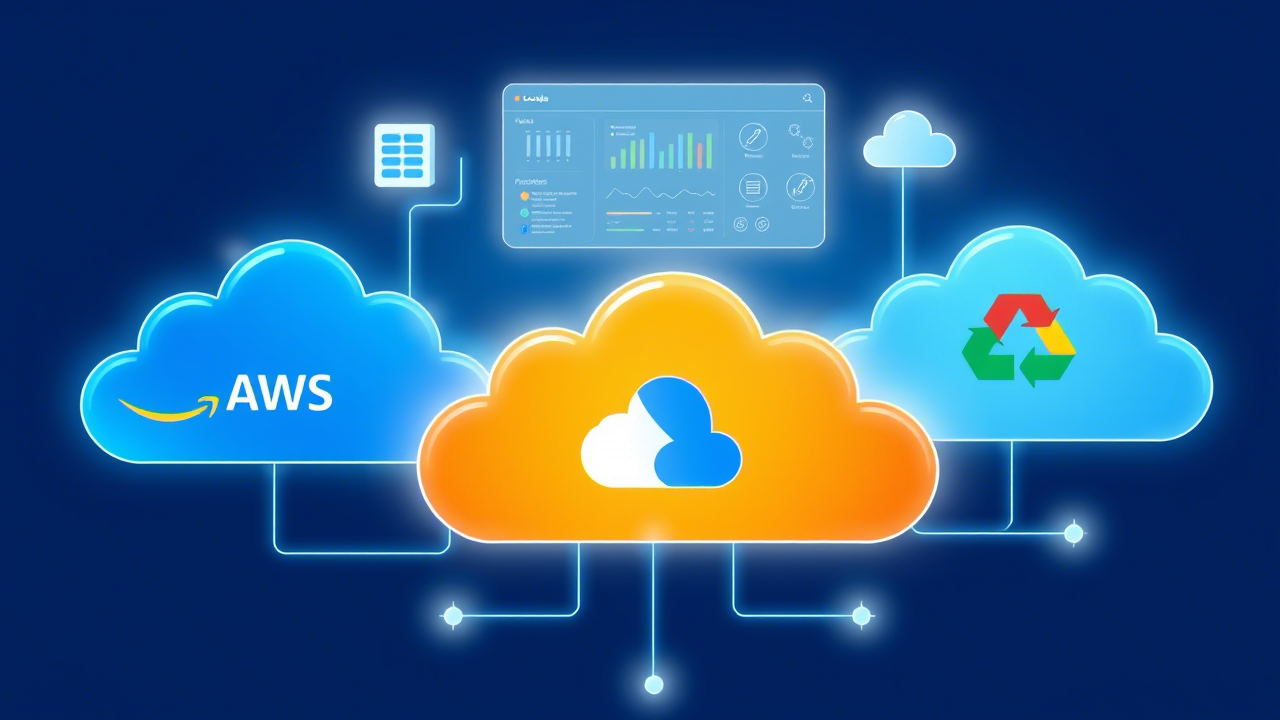In today's rapidly evolving digital landscape, organizations are increasingly adopting multi-cloud strategies to maximize flexibility, reduce vendor lock-in, and optimize their cloud investments. This approach represents a significant shift from traditional single-cloud deployments and is reshaping how businesses approach their cloud infrastructure. Let's explore how multi-cloud platforms are transforming the cloud business landscape, complete with practical use cases and a comparison to previous architectural paradigms.
What is Multi-Cloud?
Multi-cloud refers to the use of cloud services from two or more cloud providers simultaneously. This strategy allows organizations to leverage the best capabilities from different providers rather than committing to a single vendor's ecosystem. Modern multi-cloud platforms provide unified management interfaces and tools that simplify the complexity of working across diverse cloud environments.
The Pre-Multi-Cloud Era: Challenges and Limitations
Before multi-cloud platforms became mainstream, organizations typically faced several challenges:
- Vendor Lock-in: Committing to a single cloud provider often meant being bound by their pricing models, proprietary technologies, and geographic limitations.
- Limited Redundancy: Relying on a single provider created single points of failure with potentially devastating business impacts during outages.
- Geographical Constraints: Businesses with global operations struggled with latency and compliance issues when their cloud provider lacked presence in certain regions.
- Feature Limitations: No single cloud provider excels at everything, forcing organizations to compromise on certain capabilities.
- Negotiation Disadvantage: With all eggs in one basket, companies had limited leverage in contract negotiations.
Transformative Use Cases for Multi-Cloud Platforms
1. Optimized Workload Placement
Real-world example: JPMorgan Chase implements a sophisticated multi-cloud strategy, running its high-frequency trading algorithms on Google Cloud Platform to leverage Google's AI and ML capabilities, hosts customer-facing applications on AWS for its extensive global reach, and maintains sensitive financial data on Microsoft Azure to utilize Azure's robust compliance features and financial services-specific offerings.
Business impact: By strategically placing workloads on the most suitable platforms, JPMorgan Chase reduced operational costs by 24% while improving both performance and compliance posture. The bank's CTO, Lori Beer, noted in a 2023 financial technology conference that this approach has been instrumental in their digital transformation journey.
2. Enhanced Business Continuity
Real-world example: Cleveland Clinic, a leading healthcare provider, distributes its patient record systems and critical healthcare applications across AWS and Azure, with Cisco's CloudCenter orchestrating automated failover capabilities between providers.
Business impact: During a major AWS US-East-1 region outage in December 2021, Cleveland Clinic maintained 99.99% uptime by automatically redirecting traffic to Azure resources through their multi-cloud disaster recovery system. This prevented potential service disruptions for critical healthcare operations and protected access to time-sensitive patient data, potentially saving lives.
3. Geographic Compliance and Performance
Real-world example: Zalando, Europe's leading online fashion platform, uses a multi-cloud strategy spanning AWS, Google Cloud, and local European providers like OVHcloud to ensure data sovereignty compliance while minimizing latency for customers across different regions.
Business impact: By keeping European customer data on European cloud infrastructure (OVHcloud for France and Germany) and leveraging AWS's global CDN for content delivery, Zalando both complies with GDPR and reduces page load times by 40% across different markets. This strategy has helped them maintain their competitive edge in the fast-paced e-commerce space.
4. Cost Optimization
Real-world example: Netflix, the global streaming giant, dynamically shifts computational workloads between cloud providers based on real-time pricing fluctuations. While primarily an AWS customer, Netflix utilizes a proprietary multi-cloud orchestration system called "Spinnaker" to enable cloud portability and optimize costs.
Business impact: This approach has reduced Netflix's infrastructure costs by approximately 35% annually while maintaining consistent service performance. Given Netflix's massive scale (processing over 1 billion hours of streaming content daily), this translates to hundreds of millions in annual savings.
5. Best-of-Breed Capabilities
Real-world example: Siemens, the industrial manufacturing powerhouse, implements a comprehensive multi-cloud strategy using Azure for its IoT services to manage factory floor operations through Azure IoT Hub, AWS for its machine learning capabilities to predict maintenance needs via Amazon SageMaker, and Google Cloud for its BigQuery data analytics to optimize global supply chain operations.
Business impact: By leveraging each provider's strengths rather than compromising with a single vendor's offerings, Siemens accelerated its digital transformation timeline by 18 months and achieved a 23% improvement in manufacturing efficiency across pilot facilities. Their "Digital Enterprise" initiative relies heavily on this multi-cloud approach.
Leading Multi-Cloud Platform Providers
Several vendors have emerged as leaders in the multi-cloud management space, offering solutions to simplify operations across diverse cloud environments:
1. VMware (now part of Broadcom)
Platform: VMware Cloud Foundation Description: Provides consistent infrastructure and operations across clouds with vSphere, vSAN, NSX, and vRealize Key feature: Enables workload portability between on-premises, AWS, Azure, Google Cloud, and other partner clouds Link: VMware Cloud Foundation
2. HashiCorp
Platform: HashiCorp Stack (Terraform, Vault, Consul, Nomad) Description: Offers infrastructure as code, security, networking, and orchestration solutions that work across any cloud Key feature: Terraform allows infrastructure definition and deployment across multiple clouds using a single configuration language Link: HashiCorp Multi-Cloud
3. IBM
Platform: IBM Cloud Satellite Description: Extends IBM Cloud services to any environment - on-premises, edge, or other clouds Key feature: Consistent deployment and management of cloud services regardless of where they run Link: IBM Cloud Satellite
4. Cisco
Platform: Cisco Intersight Workload Optimizer Description: AI-powered platform that optimizes application performance across on-premises and multiple cloud environments Key feature: Automated resource management that ensures workload performance while controlling costs Link: Cisco Intersight
5. Google Anthos
Platform: Google Anthos Description: Platform for consistent application and service management across environments Key feature: Runs containerized applications on Google Cloud, AWS, Azure, and on-premises Link: Google Anthos
6. Red Hat (IBM)
Platform: Red Hat OpenShift Description: Enterprise Kubernetes platform that works across clouds Key feature: Consistent developer and operator experiences across infrastructure footprints Link: Red Hat OpenShift
7. Flexera
Platform: Flexera One Description: Cloud cost optimization and management platform spanning multiple clouds Key feature: Detailed cost visibility and optimization recommendations across cloud providers Link: Flexera One
How Multi-Cloud Platforms Are Changing the Cloud Business
1. Shifting Market Dynamics
The rise of multi-cloud is forcing cloud providers to compete on interoperability rather than lock-in. We're seeing increased investment in open APIs, containerization support, and cross-cloud management tools from major providers who previously preferred closed ecosystems. For example, both AWS's EKS Anywhere and Azure Arc now allow their respective Kubernetes services to run on competing clouds—something unthinkable just a few years ago.
2. Emergence of Cloud-Agnostic Tools
The multi-cloud movement has spurred development of cloud-agnostic technologies like Kubernetes, Terraform, and platform-neutral databases that work consistently across providers, reducing the technical barriers to multi-cloud adoption. Snowflake's Data Cloud platform, for instance, now operates identically across AWS, Azure, and GCP.
3. Evolution of Pricing Models
Cloud providers are responding to multi-cloud competition with more flexible pricing options, including better discounts for committed use, spot pricing, and hybrid consumption models that wouldn't have existed in a single-provider market. AWS Savings Plans and Azure Reservations have both evolved to provide greater flexibility in response to multi-cloud competition.
4. Rise of Specialized Cloud Services
The competitive multi-cloud landscape has accelerated the development of highly specialized cloud services as providers seek differentiation. This benefits businesses by providing purpose-built solutions for specific industry needs, such as AWS's FinSpace for financial services or Google Cloud Healthcare API for medical institutions.
5. New Integration and Management Platforms
An entire ecosystem of third-party tools has emerged to help organizations manage multi-cloud environments, including cost management (CloudHealth by VMware), security orchestration (Prisma Cloud by Palo Alto Networks), and performance monitoring (Dynatrace, New Relic) across providers.
Challenges and Considerations
Despite its benefits, multi-cloud adoption isn't without challenges:
- Skills Gap: Organizations need staff proficient across multiple cloud platforms, creating demand for multi-cloud certification programs like the Certified Kubernetes Administrator.
- Security Complexity: Security policies must be consistently applied across diverse environments, driving adoption of cloud security posture management (CSPM) tools like Wiz and Orca Security.
- Cost Management: Without proper governance, multi-cloud can increase costs rather than reduce them, leading to the growth of FinOps practices and platforms like CloudHealth and Apptio Cloudability.
- Data Movement: Moving data between clouds can incur significant egress fees, sometimes exceeding $0.08 per GB for inter-cloud transfers.
- Operational Overhead: Managing multiple platforms increases operational complexity, often requiring dedicated multi-cloud operations teams.
Looking Ahead: The Future of Multi-Cloud
As multi-cloud adoption continues to accelerate, we can expect:
- AI-Driven Multi-Cloud Management: Intelligent systems that automatically optimize workload placement across providers based on cost, performance, and compliance requirements. Companies like Turbonomic (now IBM) are pioneering this space.
- Cross-Cloud Native Services: More services designed from the ground up to work seamlessly across multiple clouds, like MongoDB Atlas, which provides consistent database capabilities across AWS, Azure, and Google Cloud.
- Standardization of APIs: Greater standardization of cloud APIs and interfaces to simplify cross-cloud operations, with initiatives like the Cloud Native Computing Foundation (CNCF) leading the charge.
- Industry-Specific Multi-Cloud Platforms: Specialized multi-cloud solutions tailored to specific industry requirements, such as healthcare (like Change Healthcare's cloud-agnostic healthcare platform), finance (like Finastra's banking solutions), or manufacturing (like Siemens MindSphere).
Conclusion
Multi-cloud platforms represent a fundamental shift in how organizations approach cloud strategy. Rather than choosing a single provider, businesses can now craft custom cloud environments that leverage the best capabilities of multiple providers while mitigating the risks of vendor lock-in.
For organizations still operating in single-cloud environments, the transition to multi-cloud requires careful planning but offers substantial rewards in terms of flexibility, resilience, and optimization. As the cloud market continues to mature, multi-cloud will likely become the default approach for most enterprise cloud strategies, fundamentally changing how cloud services are bought, sold, and managed.
The question for most organizations is no longer whether to adopt multi-cloud, but how to do so most effectively while managing the inherent complexity of these distributed environments. With the robust ecosystem of multi-cloud platforms now available, companies have more options than ever to create a cloud strategy tailored to their

